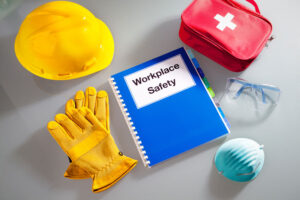Written by Scott Wilson

One of the great success stories of American industry has been the long-term reduction in the number of injuries, illnesses, and in the rate of pollution generated over the past century. Driven in part by unionization efforts in the early part of the 20th century, and further fueled by new understanding and research in environmental and health science, it’s dramatically safer to work and live in America than ever before.
A lot of that is due to the efforts of leaders in the environmental health and safety field. Someone has to take the science and research and turn it into practical procedures that reduce risk to workers and danger to the environment. That’s the role of EHS professionals.
While most of their work is subtle and behind-the-scenes, when they need to step up, they step up big. At times, they can shift the entire nature of a workplace or industry.
Environmental health and safety managers played a critical role in the sudden shift in many American companies to work-from-home during the COVID-19 pandemic… and may have permanently shifted the nature of knowledge work in the process.
But it’s a constant struggle. Safety and environmental responsibility are in constant tension with profit and efficiency. EHS management jobs are not for the easily daunted or faint of heart. To do them right, it takes individuals with the most genuine and determined kind of leadership skills.
Why Leadership Is Critical in Environmental Health and Safety Roles
 Safety leadership is a field that is often neglected until it is needed, and then it is needed a lot. Working in EHS involves constant push back against costly or complex mitigation factors. Staff may not want to adopt safer working standards because it makes their work harder or longer. Management will resist spending money on safety equipment or practices that address risks that haven’t yet been realized.
Safety leadership is a field that is often neglected until it is needed, and then it is needed a lot. Working in EHS involves constant push back against costly or complex mitigation factors. Staff may not want to adopt safer working standards because it makes their work harder or longer. Management will resist spending money on safety equipment or practices that address risks that haven’t yet been realized.
It takes a strong leader to forge ahead and drive effective EHS standards and practices in those environments. As any EHS professional will tell you, it’s not enough to issue an edict from on high and expect compliance. Nor will any number of inspections or citations change behaviors.
Horrific Accidents Show the Need for Environmental Health and Safety Leadership
 Like many corporate functions, EHS has been driven in part by government regulation. Environmental management was the first part of the job to appear on the scene, when the creation of the Environmental Protection Agency and associated clean air and water regulations in the 1970s gave companies a reason to clean up their operations and production processes.
Like many corporate functions, EHS has been driven in part by government regulation. Environmental management was the first part of the job to appear on the scene, when the creation of the Environmental Protection Agency and associated clean air and water regulations in the 1970s gave companies a reason to clean up their operations and production processes.
But EHS as whole really became a serious and recognized specialty in the wake of a humanitarian disaster that shocked the world.
At just past midnight on December 3, 1984, a methyl isocyanate tank ruptured at a Union Carbide factory outside of Bhopal, India. A series of failures in safety devices and procedures, many of which had been previously discovered but dismissed, resulted in the leak and a failure to warn civil authorities when it happened.
As many as 8,000 people were killed by the deadly gas within days, with potentially 8,000 dying from related illness over the long term. Another half-million were hospitalized, some disabled for life. And corporations around the world scrambled to hire and institute EHS teams to prevent such horrors from ever happening again.
What you ultimately need from your organization is buy-in. They have to be on board with the recommendations and best practices that you develop to protect both employees and the community. And earning that buy-in is what organizational leadership is all about.
OL studies offer you the tools and techniques needed to cultivate a vision and plan for a safer workplace, and to communicate and inspire your team to help realize it.
College Education Is a Must in Environmental Health and Safety Leadership
 Earning a college degree does two things for your career in environmental health and safety leadership.
Earning a college degree does two things for your career in environmental health and safety leadership.
First, it trains you in the skills you need to exercise leadership in all kinds of EHS roles and environments. Leadership studies over the past decades have broken down all the theories and concepts of leadership and distilled them into specific skill sets that great organizational leaders need.
While it’s possible to pick up leadership skills instinctively or through experience, it’s a lot faster to learn them in class.
Second, it offers a credential to demonstrate your commitment and expertise to employers. EHS is a field where certification and proven knowledge are king. When big companies and government agencies look for serious people to take charge, they want to see that you’ve taken the time to get the training you need to keep people safe.
Because leadership is such a useful part of the standard EHS tool set, you will find leadership specializations available in many of the professional degrees offered in the field. You can also find environmental or occupational health specializations offered in dedicated organizational leadership degrees.
The best choice for your career will depend on your current level of experience and expertise and your individual goals. The focus of each respective major will lean either toward EHS skills or leadership skills, but it’s a matter of degree. You’ll cover basically the same subjects on both paths.
When Dual Degrees Are Your Best Option for Leadership and Environmental Safety Education
 Of course, you can also choose to double up, earning both a degree in your EHS specialization and a separate one in organizational leadership. This has the virtue of doubling your expertise, with full coverage in both fields of study. But it does mean double the major course load.
Of course, you can also choose to double up, earning both a degree in your EHS specialization and a separate one in organizational leadership. This has the virtue of doubling your expertise, with full coverage in both fields of study. But it does mean double the major course load.
If there’s a bright spot, it’s that dual major programs are still faster to complete than entirely separate degrees. All the common general studies courses for the degree only need to be taken once. And if your area of expertise is complex, like chemical engineering or healthcare, dual degrees may be the only way to get professional qualifications at the level required to get a job.
Of course, you can also choose to earn a specialized bachelor’s degree in EHS and then go on to earn an OL degree at the master’s level, or vice versa.
Exploring Different Levels of Expertise in Environmental Health and Safety Education
 The formalized study of leadership and all the traits and elements that go into the development of leaders is available from colleges at the bachelor’s level and above today. EHS is a corporate function with a lot of responsibility, so even entry-level management jobs will require a bachelor’s degree at a minimum.
The formalized study of leadership and all the traits and elements that go into the development of leaders is available from colleges at the bachelor’s level and above today. EHS is a corporate function with a lot of responsibility, so even entry-level management jobs will require a bachelor’s degree at a minimum.
That means four years of study that will cost you around $37,500 on average at public universities, or $131,300 at private schools according to 2021 numbers from the National Center for Education Statistics (NCES). But those years deliver not just a broad and well-informed education in leadership and environmental health subjects, but a general education in literature, the arts, and other sciences to make you a more well-rounded professional.
You’ll find relevant degrees with titles like Bachelor of Science in Organizational Leadership and Supervision, Environmental Health and Safety Concentration or a Bachelor of Science in Organizational Leadership Occupational Safety and Health Concentration, or a Bachelor of Science in Environmental, Health, and Safety Management. In some cases, you might even find that a BSOL Industrial Leadership Specialization may offer EHS coursework.
The next step up is the master’s degree, with one to two year courses of study that deliver a much more in-depth level of expertise. According to NCES, these programs cost about $12,410 per year at public colleges, and $26,597 at private universities in 2021.
Master’s programs really take both your leadership and EHS management skills up a notch, and are suitable for senior leaders in major corporations or at government regulatory agencies. It’s most common to find degrees in the specialty, such as a Master of Science in Occupational Safety and Health, Safety Management Concentration.
 Depending on the angle from which you are entering the EHS field, you might also find other kinds of master’s programs with leadership training useful, such as a Master of Public Health in Occupational Safety and Health Management with an Organizational Leadership Concentration or a Master in Public Service and Safety Leadership.
Depending on the angle from which you are entering the EHS field, you might also find other kinds of master’s programs with leadership training useful, such as a Master of Public Health in Occupational Safety and Health Management with an Organizational Leadership Concentration or a Master in Public Service and Safety Leadership.
You can also find degrees offered at the very highest level of environmental health and safety such as a PhD in Environmental Health, PhD in Environmental and Occupational Health, or a PhD in Safety Sciences. These have the same tuition rates as master’s programs, but can take anywhere from four to seven years to complete.
Although doctoral programs offer more training and advanced research opportunities, most of them are aimed at preparing graduates for academic roles rather than leadership positions. However, the flexibility inherent in a doctoral degree means you can fine-tune your studies toward almost any relevant goal.
The final option in formal education in EHS for leaders comes through certificate programs. These are short courses, lasting less than a year, with perhaps three or four classes to complete. They are found at post-secondary, graduate, and postgraduate skill levels, so you can match the intensity to your current career goals. They come without the larger scope of a full degree, but if you specifically need to close only a few gaps in your EHS or leadership skills, they are a quick and inexpensive way to make it happen. A certificate in Management and Leadership Skills for Environmental Health and Safety Professionals, a Graduate Certification in Environmental Health and Safety Management, or an Occupational Health and Safety Management Certificate might be exactly what you need.
What You Will Study in a Leadership Program for Environmental Health and Safety Professionals
While they will come with different levels of expertise and intensity, you’ll find many of the same essential courses no matter what kind of degree or certificate you decide to pursue.
Leadership Process – The theory and practices of effective organizational leadership offer firm foundations for your own style and techniques. You’ll go through the research that backs up modern leadership theory as well as going through case studies showing how effective organizational leadership functions in practice.
Change and Conflict Management – Working in EHS inevitably means dealing with conflict. Your entire job will revolve around telling people to do things differently. Learning how to discuss and manage those changes, and to deal with the conflict that rises when management or staff resist them, will be a key part of your education. You’ll learn conflict resolution and negotiation skills, as well as picking up the communication abilities to deliver tough messages with grace and tact.
Fundamentals of Environmental Health and Hygiene – Strong background courses in the essential science of water, air, and other environmental safety and security give you the foundations for learning about industry-specific concerns you will face on the job. You’ll cover basic germ theory, common contaminants and sources of contamination, and learn how to develop systems to safeguard products and processes.
Environmental Safety Management and Regulation – It’s the job of EHS leaders to know the rules and make sure everyone is in compliance. A lot of the job, then, revolves around keeping tabs on the latest developments in EHS regulation and staying on top of requirements that may be coming down the pipe. These courses familiarize you with the overall regulatory system as well as the specific information you will need to absorb to do your job.
Psychological and Sociological Factors in Environmental Health and Safety – This coursework will cover the social and behavioral psychology of humans in the workplace. While this is important for every kind of organization leader to understand, it’s especially important in EHS work, where social and psychological factors are some of the greatest weaknesses to guard against in safety issues.
Leadership Communications – Clarity and specificity are prized in EHS circles. The stories of miscommunication leading to catastrophe are too many to count, but you will certainly page through a lot of them to learn how to avoid similar disasters. But leaders in EHS have to exercise more than just the usual level of communication skill. Instead, they have to learn how to communicate strategically, making their points in ways and to people who can ultimately support larger organizational goals.
Of course, the more specialized your degree program, the more specific the classes will be. You may have additional required coursework in chemistry, biology, healthcare, or other environmental sciences on top of your leadership studies.
Electives and Research Opportunities Round Out EHS Leadership Degree Programs
 Environmental health and safety is a broad field, with a lot of highly specific knowledge required in different industries and areas. So you can expect that you degree program will come with many additional elective courses that allow you to shape your studies toward your intended career path.
Environmental health and safety is a broad field, with a lot of highly specific knowledge required in different industries and areas. So you can expect that you degree program will come with many additional elective courses that allow you to shape your studies toward your intended career path.
These classes offer all kinds of ways to further develop not just your personal leadership skills, but also your expertise in areas such as:
- Industrial Ergonomics
- Accident Investigation
- Hazardous Materials Safety and Handling
- Emergency Management
- Safety Engineering
- Construction Safety
- Environmental Health and Safety Rules and Legislation
Additionally, many EHS and leadership degree programs offer internships and other kinds of practical experience to expose you to current practices in the field.
While working with current EHS leaders in business and government, you’ll absorb the state-of-the-art in the field when it comes to both technology and leadership practices.
At the graduate level, you can also expect to engage in significant and sometimes original research looking at existing EHS practices and how they can be improved. It’s a field where academic investigations often lead to new and safer approaches to management, so you have a chance to make genuine contributions before you ever graduate.
Grad students also typically have to complete a thesis or dissertation, or a capstone project, to round off their advanced studies. These in-depth projects or papers give you a showcase to put together everything you have learned into a package that demonstrates your understanding and accomplishments.
Finding the Right School To Pursue Leadership Studies in Environmental and Health Safety
 Choosing the right university for your EHS and leadership studies requires threading a needle between two very different fields.
Choosing the right university for your EHS and leadership studies requires threading a needle between two very different fields.
For starters, you need a school where the hard sciences and the study of industrial safety is taken seriously. It should have good connections in the industry you are planning to work within, offering networking and experiential learning opportunities to make it easy for you to land jobs after graduation.
But you also want a college that has the right expertise in social sciences and the soft skills of communication, philosophy, and behavioral psychology to underwrite your leadership studies. It should offer all the resources you need for study and research, and offer excellent academic advising and tutoring to help you through the tough spots.
Finally, you want a college with top-notch instructors in all those fields. They should have both practical experience as well as recognized academic expertise. When you crack open a journal in EHS, you want to see some of those names on the article bylines. Only effective instruction can really give you the sort of education you need to develop strong environmental health and safety leadership skills.
Depending on the exact major you pick, you may get some help in making that choice by looking at whether or not these programs have a specialty accreditation. Specialty accreditors go above and beyond the typical accreditation standards all serious American schools already meet. They use their connections within their industry and knowledge of the field to conduct in-depth evaluations, approving only programs that meet the high bar required.
Leadership degrees are offered by many different kinds of schools, not all of which are eligible for specialty accreditation. But for EHS leadership programs, you might check to see if the school and degree have received an accreditation from agencies like EHAC, the National Environmental Health Science and Protection Accreditation Council, or ABET, the Accreditation Board for Engineering and Technology.
Online Programs Make Degrees Easy for Senior Executives
 An online degree program might offer the best fit for anyone climbing the leadership ladder in environmental health and safety. Unless you are just starting out, chances are you already have a position that has some real professional obligations that can require your attention at almost any hour.
An online degree program might offer the best fit for anyone climbing the leadership ladder in environmental health and safety. Unless you are just starting out, chances are you already have a position that has some real professional obligations that can require your attention at almost any hour.
Conventional class schedules won’t bend around that kind of work, but online programs can. With asynchronous scheduling, they let you shift when you do your homework, when you watch class lectures, or when you chat with fellow students around to different times of day on different days.
So if you’re out late inspecting an oil well field and need to catch up on some sleep instead of bolting out of bed for class the next morning, you’re in luck—file that next assignment on your lunch break. Drop in on an online chat discussion about it after dinner. And keep your family happy and your grades up without breaking a sweat.
Jobs in Environmental Health and Safety Exist in Every Industry
There’s really no field or industry today that doesn’t have a role for leaders in environmental health and safety.
Although manufacturing, mining, and other industrial jobs are usually the first to spring to mind, EHS has a big-picture, holistic perspective on safety today. So you can just as easily land a job at a software company, working on ergonomics and fighting sedentary work habits as you can taking a position at a deep-rock mine, monitoring water contamination and ensuring breathable atmosphere two kilometers below the surface.
It’s most common for people with leadership skills in EHS to advance to positions where they are supervising teams that do this work. But leadership skills come in handy even when you are on your own in this field.
That means positions such as environmental health and safety specialists, industrial ecologists, and occupational health and safety specialists are all on the table. And if you play your cards right, senior level roles for leaders in EHS like Chief Environmental Officer are a possibility. Other times, EHS can lead to more generalized management roles, like COO, or Chief Operating Officer.
What Are Typical Salaries for Leaders in Environmental Health and Safety?
 Salaries in environmental health and safety can bounce around quite a lot from industry to industry and role to role. Specialists in high-risk areas like healthcare, manufacturing, and construction are likely to make more than those in other industries. Naturally, your personal experience and background, as well as your level of leadership education, will also have an impact on pay.
Salaries in environmental health and safety can bounce around quite a lot from industry to industry and role to role. Specialists in high-risk areas like healthcare, manufacturing, and construction are likely to make more than those in other industries. Naturally, your personal experience and background, as well as your level of leadership education, will also have an impact on pay.
The Bureau of Labor Statistics (BLS) keeps track of all of this data, but EHS jobs may be categorized differently depending on their focus and scope.
For example, Occupational Health and Safety specialists are those most focused on internal health and safety practices. Those in the top ten percent of the occupation, which is likely where a leadership degree will place you, earned more than $118,510 in 2021.
But you might also find jobs that fall into the category for Environmental Specialists, who may look more broadly at the health and safety impacts of businesses in the community. For those positions, the top ten percent made more than $129,070.
And if you go all the way to earning a master’s degree in the field, climbing the leadership ladder at your company or agency, you may wind up in the area that BLS categorizes as Top Executives. For those jobs, the median wage was $98,980 per year in 2021, with the top ten percent making more than $208,000 annually.
That’s a solid paycheck coming in for simply doing your best to protect your workers and your community. And it’s well worth the investment in a degree in organizational leadership to learn the skills it takes to get the job done.
2021 US Bureau of Labor Statistics salary and employment figures for Occupational Health and Safety Specialists and Technicians, Environmental Scientists and Specialists, and Top Executives reflect national data, not school-specific information. Conditions in your area may vary. Data accessed February 2023.

